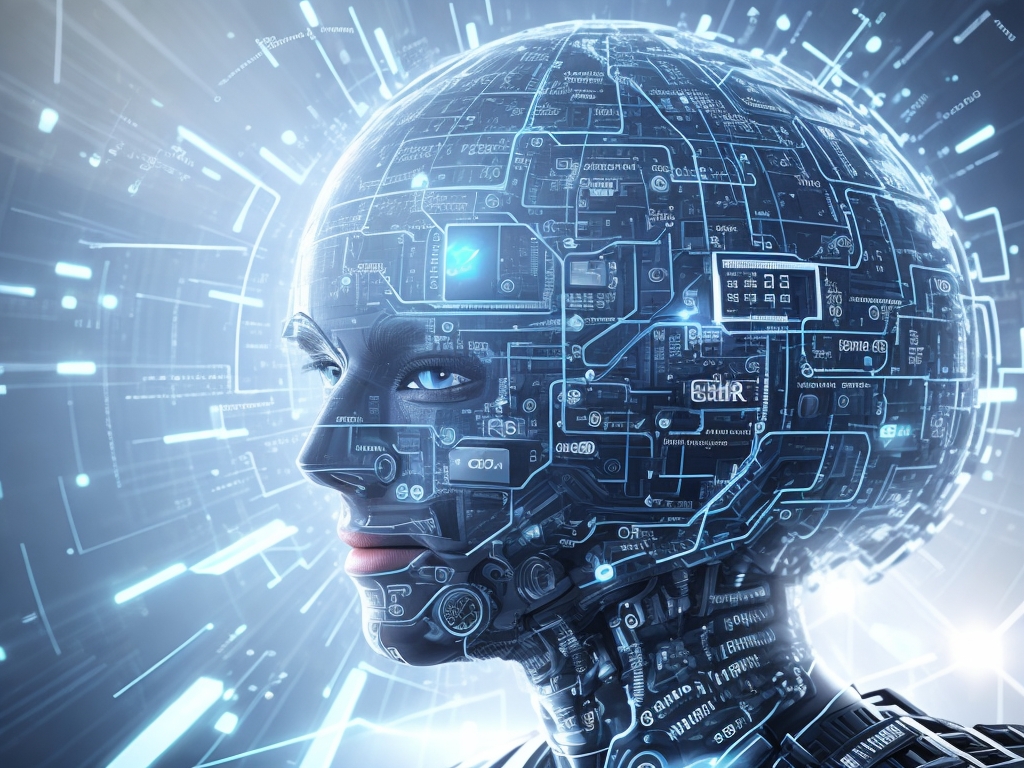What is Augmented AI?
Imagine you had an assistant who was really smart. This assistant could answer difficult questions, solve complex math problems, write eloquent essays – you name it.
Now imagine, this assistant wasn’t perfect. It made some mistakes here and there. But with your help and guidance, it continued to learn and improve. Together you formed an unstoppable team, combining your creative human insights with its computational genius.
This, in a nutshell, is the promise of augmented artificial intelligence.
Augmented AI systems partner humans and machines so each can play to their strengths.
Humans provide common sense, ethics, creativity, and strategy. AI systems provide speed, scalability, and quantitative precision. While AI on its own has limitations, by bringing humans “into the loop”, we unlock its full potential.
Augmented AI aims for the best of both worlds.
How is Augmented AI Different from General AI?
General artificial intelligence (or artificial general intelligence), refers to machines that can perform intellectual tasks as well as any human across the board.
Think Rosie the Robot from The Jetsons or Jarvis from Iron Man.
The goal is to create artificial human equivalents – in contrast to narrow systems tailored to specific use cases like playing chess or scheduling meetings.
Augmented AI has no pretensions of matching overall human intelligence. The focus is entirely on combining strengths rather than replication.
It’s less “man versus machine” and more “man plus machine”. Together, humans and computers excel at tasks that neither can perform alone.
Real World Examples of Augmented AI
Augmented intelligence is already widely used in domains like healthcare, finance, retail, transportation, and more. While full automation is still on the cards, augmenting human operators with AI assistance boosts efficiency and accuracy over purely manual approaches.
Healthcare
In medicine, AI systems analyze patient data – including medical images, electronic records, and genetic profiles – to uncover patterns human doctors might miss.
For example, algorithms can detect early signs of illness or predict patients at risk for conditions like sepsis or heart disease. Doctors combine these AI insights with their expertise to make better diagnoses and treatment decisions.
Finance & Investments
Financial advisory firm Vise provides portfolio recommendations to human managers by crunching volumes of data no human could process alone.
Together, humans leverage both machine learning and their own market intuitions to optimize investment strategy.
Retail & E-Commerce
Retail giants rely on AI to optimize pricing, logistics, product search, recommendations, and more based on huge volumes of customer data. Humans define business goals, interpret results, and apply common sense checks to catch edge cases.
For example, Walmart uses AI to plan weekly promotions, tailor them to local demand signals, and route supply chain logistics in real time. Humans provide oversight and strategic guidance.
Content Marketing
AI can augment human marketers and content creators in several ways.
AI writing assistants can help generate first drafts of content like blog posts, articles, product descriptions, and marketing copy based on prompts and guidance from human writers. The AI handles the initial heavy lifting, while humans review, edit, fact-check, and refine the content to ensure it meets quality standards.
AI can also analyze existing content and provide data-driven insights on how to optimize it for better search engine rankings, user engagement, and conversions.
Autonomous Vehicles
Fully autonomous self-driving remains an open challenge. But augmented options have already hit the roads.
For example, Tesla Autopilot handles mundane highway driving under human supervision. Human pilots remain responsible for complex unexpected situations while robots assist with routine navigation.
Smart Reply in Messaging Apps
When chatting on mobile, smart reply options generated by AI saves typing time without sacrificing control.
Algorithms craft plausible responses based on context. Humans select the best suggestion or override it with a custom message. Together, this speeds up conversations via collaboration.
Why is Augmented Intelligence Useful?
Augmented intelligence combines the complementary strengths of humans and artificial intelligence. This symbiotic relationship amplifies capabilities beyond what either can accomplish independently:
Volume: Humans excel at reasoning, creativity, and strategy. But we’re limited in how much data we can process. AI systems easily crunch endless streams of data to uncover insights we’d never discern alone.
Velocity: AI systems respond in microseconds, while human analysis takes minutes, hours, or longer. Augmented intelligence pairs human judgment with machine speed and responsiveness.
Variety: Humans interpret the world via sensory perception and lived experience. However, we can only access certain datasets and environments. AI expands our reach to new, non-intuitive patterns across wider data.
Veracity: Humans use intuition, common sense, and ethics to evaluate ideas. But we’re prone to fatigue, bias, and misjudgment. AI counters human fallibility with tireless statistical analysis.
Value: Humans determine objectives, set strategy, and define success metrics. We specify what value means in any context. AI optimizes the mechanistic execution of tasks to maximize outcomes as defined by people.
Challenges with Implementing Augmented Intelligence
While promising, efforts to augment human intelligence face barriers around trust, transparency, bias, and control. Smooth collaboration requires overcoming these hurdles.
Trust & Understanding
Humans rightfully tend to distrust processes we don’t understand. But modern machine learning models are notoriously opaque, often termed “black boxes”.
We input data and output predictions emerge without explanations of inner workings. This masks potential biases and inconsistencies that undermine reliability without visibility. Humans must scrutinize model behavior to calibrate appropriate confidence.
Bias & Fairness
AI systems inherit any biases in their training data. Machine learning models can discriminate based on sensitive attributes like race, gender, and age without transparency. And statistically “optimal” results often optimize for overall accuracy without considering fairness across groups. Humans must audit for and address potential harms through ongoing oversight.
Agency & Control
Humans must remain responsible stewards, establishing objectives and guardrails aligned with ethics and values. Full automation without human involvement surrenders too much control. But active partnership preserves self-determination. Humans must stay “in the loop” through transparent collaboration rather than passive obedience.
Responsible Implementation Guidelines
Effectively implementing augmented intelligence requires following principles and best practices around transparency, bias detection, user control, and more:
- To ensure due process, maintain clear human oversight and responsibility for all automated decisions impacting individuals or groups.
- Provide visibility into how automated systems make decisions, including explanations of input factors and confidence to enable human judgment.
- Establish rigorous testing procedures for potential biases and discriminatory impacts, particularly across protected groups. Actively measure and mitigate identified issues.
- Give individuals agency through features to request a human review of any automated decisions and appeal outcomes deemed unfair or harmful.
- Allow user customization and overrides of automated interactions to preserve autonomy and self-direction.
- Slowly establish trust and understanding by ramping up automation gradually in low-risk environments before expanding to higher-impact areas.
The above guidelines promote ethical augmented intelligence where AI transparency and accountability prevent harm. They maximize the benefits of human+machine collaboration while answering legitimate concerns.
Promising Frontiers for Augmentation
Many future growth areas are ripe for human-AI collaboration. A few particularly promising domains include:
Creative Work AI shows early promise for augmenting human creativity – from generating music and art, to aiding computer programming, writing and design.
For example, tools like Tabnine and Copilot autocomplete code based on statistical patterns. Humans guide the direction and override any nonsensical suggestions.
Scientific Discovery AI is exponentially accelerating areas like materials science, drug discovery, and quantum physics by systematically analyzing combinations far exceeding human capacity. But humans frame hypotheses, interpret results, and determine the next experiments.
Education AI adaptive learning systems customize teaching to student needs by modeling knowledge gaps. Humans develop overall curricula aligned to pedagogical best practices. Together this boosts outcomes beyond one-size-fits-all instruction.
The common thread is combining human judgment and ethics with machine optimization of repetitive tasks. This frees us to focus on higher reasoning and creative work.
The Future of Intelligence is Collaborative
Rather than framing artificial intelligence as competition, augmented intelligence emphasizes friendly partnerships between people and machines. Together we form complementary teams that outperform either alone. By seamlessly integrating AI into workflows, we indirectly amplify our abilities.
The future promises a symbiotic intelligence explosion as human and machine cognition further intertwine. Each iteration makes our augmented potential more powerful and more ethical. Workplaces that embrace this trend will have a competitive advantage in leveraging exponential technologies through human/AI collaboration.
So don’t fear smart machines – figure out how to work with them! Together, augmented intelligence will take us to amazing places.




